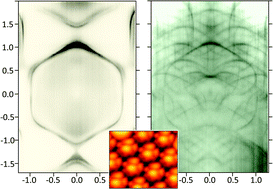On the problem of Dirac cones in fullerenes on gold†
Abstract
Artificial graphene based on molecular networks enables the creation of novel 2D materials with unique electronic and topological properties. Landau quantization has been demonstrated by CO molecules arranged on the two-dimensional electron gas on Cu(111) and the observation of electron quantization may succeed based on the created gauge fields. Recently, it was reported that instead of individual manipulation of CO molecules, simple deposition of nonpolar C60 molecules on Cu(111) and Au(111) produces artificial graphene as evidenced by Dirac cones in photoemission spectroscopy. Here, we show that C60-induced Dirac cones on Au(111) have a different origin. We argue that those are related to umklapp diffraction of surface electronic bands of Au on the molecular grid of C60 in the final state of photoemission. We test this alternative explanation by precisely probing the dimensionality of the observed conical features in the photoemission spectra, by varying both the incident photon energy and the degree of charge doping via alkali adatoms. Using density functional theory calculations and spin-resolved photoemission we reveal the origin of the replicating Au(111) bands and resolve them as deep leaky surface resonances derived from the bulk Au sp-band residing at the boundary of its surface projection. We also discuss the manifold nature of these resonances which gives rise to an onion-like Fermi surface of Au(111).



 Please wait while we load your content...
Please wait while we load your content...